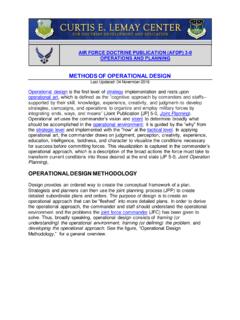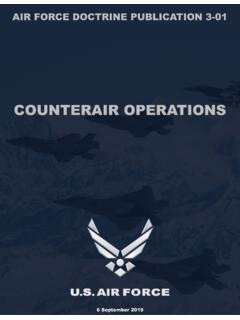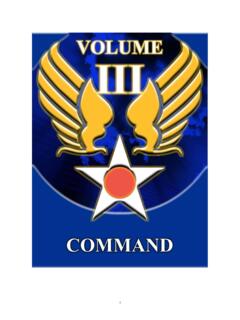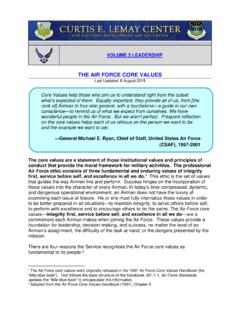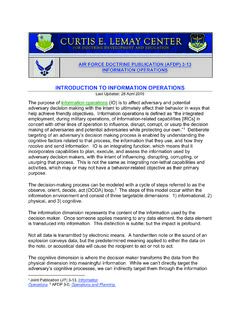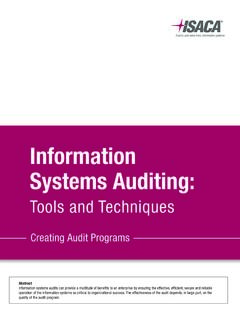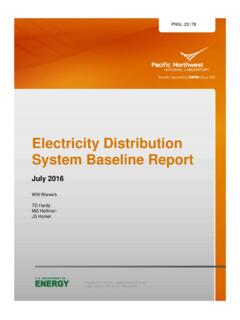Transcription of JOINT INTELLIGENCE PREPARATION OF THE OPERATIONAL …
1 AIR FORCE DOCTRINE PUBLICATION (AFDP) 2-0 GLOBAL. INTEGRATED INTELLIGENCE , SURVEILLANCE &. RECONNAISSANCE OPERATIONS. JOINT INTELLIGENCE PREPARATION OF. THE OPERATIONAL ENVIRONMENT. Last Updated: 29 Jan 2015 . JOINT INTELLIGENCE PREPARATION of the OPERATIONAL Environment (JIPOE) is a valuable methodology focusing INTELLIGENCE , surveillance, and reconnaissance (ISR) for the commander and the commander's supporting command and control (C2) elements by getting inside the enemy's decision-making cycle. Specifically, JIPOE focuses analysis on the adversary, the OPERATIONAL environment (OE), and the effect of the OE. on both friendly and enemy COAs. JIPOE and INTELLIGENCE PREPARATION of the battlespace (IPB) are key tools for conducting analysis and production that directly support C2 planning and direction processes.
2 The key distinction between JIPOE and IPB is the supported commander. Combatant commands and JOINT forces conduct JIPOE while Service components provide service-level IPB. JIPOE/IPB results in the production of an INTELLIGENCE estimate, potential adversary courses of action (COAs), named areas of interest, and high-value targets, which are inputs to the JOINT operation planning process (JOPP) and the JOINT force commander (JFC) and commander, Air Force forces (COMAFFOR) planning and targeting processes. The JIPOE process includes integrating analysis, production, collection management, and targeting processes to shape decision making and enable operations.
3 Finally, JIPOE is a significant enabler for commanders to leverage or support the full range of instruments of national power (diplomatic, information, military and economic) to ensure shaping ops deter adversary actions or if deterrence fails, set conditions for successful operations should conflict occur. Detailed threat analysis is critical for friendly force mission planning and defense suppression across all domains. JIPOE assesses how the enemy doctrinally organizes, trains, equips and employs their forces against friendly force vulnerabilities. JIPOE also assesses the cultural, social, religious, economic, and government elements of the country/region and determines the possible effects of enemy and friendly COAs on them.
4 JIPOE alerts decision-makers at all echelons to potential emerging situations and threats. JFC guidance provided during planning shapes the overall concept of operations, which in turn drives planning requirements for air, space, and cyberspace employment. The challenge of the JFACC/commander, Air Force forces (COMAFFOR). is determining where and when to focus attention in order to influence events early, ready forces, and begin setting conditions for future operations. Therefore, PREPARATION of the OPERATIONAL environment is essential to supporting the commander's visualization process, determining (component-level) INTELLIGENCE requirements, anticipating critical decision points during operations, and prescribing rules of engagement (ROE).
5 IPOE contributes to those enabling functions to plan and prepare for potential follow-on military operations. For example, global integrated ISR provides the INTELLIGENCE needed to understand how an adversary's networks can be affected by non-kinetic (cyberspace and information operations) capabilities. The global integrated ISR. contribution includes but is not limited to identifying data, system/network configurations, or physical structures connected to or associated with the network or system, determining system vulnerabilities, and suggesting actions warfighters can take to assure future access and/or control of the system, network, or data during anticipated hostilities.
6 JIPOE, target system analysis, and target development processes highlight an adversary's centers of gravity (COGs), key capabilities and vulnerabilities, possible intentions, and potential COAs. By identifying known adversary capabilities, JIPOE. provides the conceptual basis for the JFC and COMAFFOR to visualize how the adversary might threaten friendly forces or influence mission accomplishment. JIPOE is the process in which critical thinking skills are applied to effectively counter an adversary's denial and deception strategy and anticipate surprise. Ultimately, JIPOE. shapes the JOPP and by extension, the air component's air operations plan , operations order, and air operations directives.
